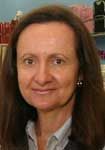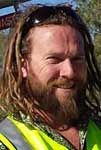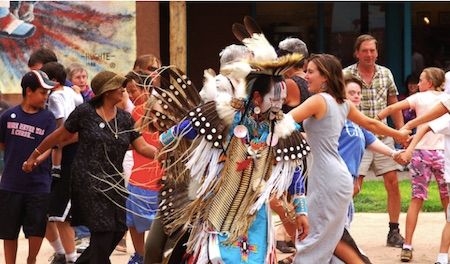National Indigenous Cultural Centre to be 'community-led'
26 March 2018
Mayor favours Rugby codes going to Gillen

Above: National Indigenous Cultural Centre committee members, from left, Owen Cole, Harold Furber and Deanella Mack at last Thursday’s public information session.
By KIERAN FINNANE
With additional reporting by ERWIN CHLANDA
The National Indigenous Cultural Centre will be “community-led”, “working in reverse” to the government’s process on the National Indigenous Art Gallery: the criticism was understated but explicit from the Cultural Centre project leaders in a public information session held last Thursday.
The next day the NT Government announced Anzac Oval as the preferred location for the National Indigenous Art Gallery (NIAG) – flying in the face of the Aboriginal-led steering committee’s recommendation of the Desert Park.
Meanwhile Mayor Damien Ryan early this afternoon, in response to questions from the Alice Springs News Online, has announced he favours the Anzac site and the relocation of the two Rubgy codes to Bradshaw Drive (see UPDATE at the bottom of this report.)

It is worth stating that there has never been a public information session for the National Indigenous Art Gallery. As MLA Robyn Lambley (right) said to the News following the government’s announcement: “We have been kept in the dark and we’re still in the dark.”
The online survey about NIAG proposed two location choices, “with no explanation about how they were derived” which was “unsatisfactory by any measure”, she said. Now, even with the announcement of Anzac Oval as the preferred option, there has been no further explanation or “nuts and bolts” detail.
She, as an Alice Springs Member of Parliament, had not seen the steering committee report before the government’s public release of it on Friday. The same goes for the Alice Springs Town Council, according to Councillor Jimmy Cocking, yet the Town Council, on behalf of the community, owns Anzac Oval, which makes up a good part of the proposed NIAG location (the other part being the site of the former Anzac Hill High, now St Joseph’s Flexible Learning Centre).
There is confusion in the community over the two distinct projects with many people not even aware that there are two and many also expressing the view that the two should be one.
That they be separate is the NT Government’s decision, said NICC steering committee member Owen Cole at the information session: “We have accepted that.”
The NT Government has committed $20m to support the Cultural Centre, separate from the $50m for the Art Gallery.
Critical to the Cultural Centre project, which will tell the story of Australia from an Indigenous perspective, is that it be Indigenous-led and -controlled. Their self-starting committee, chaired by Arrernte man Harold Furber, is made up entirely of Indigenous people.
In comparison, the NIAG project is now without any Indigenous leadership. Its original steering committee, co-chaired by Aboriginal leaders in the art world, Hetti Perkins and Philip Watkins, finished its work in November, when it handed in its report.
Leaders of the NIAG are now Chief Minister Michael Gunner and Tourism and Culture Minister Lauren Moss. Aboriginal MLA Chansey Paech was formerly an Assistant Minister on this project but is no longer.
It is not yet clear how much of the NIAG steering committee report the government will take on board, but on the question of location, which the government, not the committee, made the priority issue, that committee has been rebuffed. Not a good start.
 On this point Cr Cocking (left) says ensuring that Aboriginal people are “front and centre” of the gallery project should be the government’s “number one priority”. (Cr Cocking is expressing his own views, not speaking on behalf of council.) At the same time, he sees value in a CBD location, as does Mrs Lambley who continues to favour the old Melanka site. Cr Cocking says the site at the foot of Anzac Hill , “if approached in the right way”, could be “a site of national and international significance”.
On this point Cr Cocking (left) says ensuring that Aboriginal people are “front and centre” of the gallery project should be the government’s “number one priority”. (Cr Cocking is expressing his own views, not speaking on behalf of council.) At the same time, he sees value in a CBD location, as does Mrs Lambley who continues to favour the old Melanka site. Cr Cocking says the site at the foot of Anzac Hill , “if approached in the right way”, could be “a site of national and international significance”.
The Cultural Centre, having committed to a bottom-up Indigenous-led approach, is not afraid to take the time necessary to build a national consensus and vision for the project. Mr Cole says the committee will give themselves the next 12 months, during which he and Mr Furber will go on “a roadshow” around the country, conducting consultations with Indigenous cultural organisations in each state and territory.
Some of these organisations have already participated in consultations that were held in Alice Springs in October last year, during which unanimous support was expressed for the national centre to be located in Alice Springs, said Mr Furber. In keeping with the spirit of this national focus, the project, previously known as Nganampa Anwernekenhe, was formally renamed the National Indigenous Cultural Centre (NICC).
While there have been informal conversations outside of Alice Springs and the NT about the NIAG project, there have been no such structured consultations in Central Australia, let alone anywhere else. Comprehensive consultations were a priority for the next stage of the project, Ms Perkins and Mr Watkins told the ASNO, and the report outlines a process for such consultations.
To have any credibility, the government won’t be able to avoid some kind of national-level consultation with Indigenous cultural leaders and organisations, but there is no sign of them taking their time.
Mr Gunner has announced a construction start date of 2020 for a project that has yet to be adequately financed apart from anything else. The NT Government has promised $50m for the project but the expected price tag is $150m, and, according to the ABC, Ms Moss was “non-committal when asked if any specific agreements had been reached”: “We’ll be working with national organisations and we’ll be looking to work with the Federal Government on this,” Ms Moss said.
Mrs Lambley pointed out that the next NT election is due in August 2020. Is this what is driving the NT Government’s haste?
“The start of 2020 is less than two years away,” she said. “How is it all going to pan out before the bull-dozers go in? How will an alternative venue for rugby league be constructed and the rest of the finance for the gallery be found in less than two years?
“I don’t see how they can achieve this before the next election, they won’t. A hell of a lot has to be achieved. I truly don’t know that it’s possible given the information we have available.”
Enough of the unflattering comparisons between the two projects, let’s hear more on the Cultural Centre.
Mr Furber and Mr Cole have travelled to a number of international Indigenous cultural centres. Most fruitful for their purposes was their visit to the Indian Pueblo Cultural Centre in Albuquerque, New Mexico, USA.
 It presents itself as “a world-class museum and cultural center created as a place where Pueblo people can tell their story” and as “the gateway to the 19 Pueblos of New Mexico”.
It presents itself as “a world-class museum and cultural center created as a place where Pueblo people can tell their story” and as “the gateway to the 19 Pueblos of New Mexico”.
Left: Experiencing Pueblo culture. Image from the Indian Pueblo Cultural Centre website.
It has permanent exhibits “providing an introduction for understanding the state’s landscape, legacy, and story of continuance” as well as the Pueblo Harvest Cafe featuring New Native American cuisine and the Shumakolowa Native Arts shop, “a trusted destination for authentic handcrafted Native American art, pottery, and jewellery”.
Of particular interest to Mr Cole and Mr Furber is its schedule of cultural, educational, and community activities including rotating exhibits and events.
According to Mr Cole, these are in the hands of the different Pueblos, staging exhibits and events specific to them. This kind of “hub and spoke model” would be a way of involving the different, already existing Indigenous cultural organisations throughout Australia, and of ensuring a “sense of ownership” and true national representation.
Art is part of culture and will be part of the Cultural Centre but the core purpose is to tell “the national story from the beginning”, from an Indigenous perspective, and starting with the continent, said Mr Furber.
There is no comparable institution in Australia. Such a lack would be “unthinkable across the ditch”, he said, citing Te Puia in Rotorua, New Zealand, a centre for experiencing Maori culture and the country’s geothermal wonders. Its contemporary underpinnings go back to the early 20th century, with the first carving school, Te Ao Marama, designed to preserve and maintain Maori material culture, opened on the shores of Lake Rotorua.
 The school became a legal entity, the Rotorua Māori Arts and Crafts Institute, and was joined with the local Te Whakarewarewa Valley’s tourism interests under 1963 legislation, amended in 1967 to recognise the institute as a national organisation. The main physical structure, Te Aronui a rua Marae (meeting house) was built between 1967 and 1981 (pictured at right, image from the Te Puia website).
The school became a legal entity, the Rotorua Māori Arts and Crafts Institute, and was joined with the local Te Whakarewarewa Valley’s tourism interests under 1963 legislation, amended in 1967 to recognise the institute as a national organisation. The main physical structure, Te Aronui a rua Marae (meeting house) was built between 1967 and 1981 (pictured at right, image from the Te Puia website).
Mr Furber said he wasn’t aware of Te Puia or the Pueblo Cultural Centre until recently.
Australia “needs” such a project. The story a National Indigenous Cultural Centre could tell will be “wonderful and exciting” as well as “gut-wrenching and emotional”, “truth-telling”, said Mr Cole.
A video presentation said that it will be a place to hear the sound of Indigenous languages, to learn about culture from ancient to present-day, to learn about “the true extent of what went on in the post-colonial era” and during the Stolen Generations – “there was no period any sadder”.
Australia will be “a richer place” for being able to talk truthfully about its history, said Mr Cole.
Both men made points about what the centre will not be: it will have nothing like the “ethnographic” approach of a “normal museum” with little to no control exercised by the Indigenous community, said Mr Cole: it will not be “a keeping place” for Indigenous material culture, said Mr Furber – such places already exist, the local example being the Strehlow Research Centre.
It represents a fantastic opportunity for Indigenous training and employment, across the spectrum of positions from curatorial to grounds maintenance.
This aspect was particularly endorsed by committee member Deanella Mack, who runs her own cultural services enterprise, Cultural Connections, and leads visitors on cultural tours through Standley Chasm, known to Arrernte people as Angkerle Atwatye.
These tours have driven home to her how little most visitors, whether Australian or international, know about Aboriginal history and culture and at the same time how much they want to learn.
She also sees the centre as a learning opportunity for other Indigenous people, many of whom these days have grown up without knowing “their own story”. She herself was “blown away” by “how rich” the story was that she learnt in adulthood.
Mr Cole said the centre should be underpinned by commercial enterprise, to reduce reliance on government funding, although as a national project, the centre certainly “warrants national funding”.
Negotiations with government as well as corporate and philanthropic sectors will follow the next period of intensive community consultations.
The committee called on locals to support their endeavour.
“We are all in this valley together,” said Mr Furber. “We can show the world that we can do things differently, we don’t have to live with the negatives that are put out there all the time.”
UPDATE 2:10pm
Mayor Damien Ryan early this afternoon, in response to questions from the Alice Springs News Online, has provided the following statement:-
Personally, I support the NT Government’s preference to use the old ANZAC Hill high school site for the National Indigenous Art Gallery, as the NT Government intends to relocate Rugby League and Union. My understanding is that an area alongside Bradshaw Drive is being considered for a purpose-built complex, which I would also support.
This is an opportunity to secure a strong outcome for the whole of our community, including Rugby.
I look forward to commencing negotiations around the use of this space. I’m seeking assurances that Totem Theatre and the 50+ Community Centre will be preserved, and that an open green space will be preserved for concerts and other community events.
I will be pursuing a contract with the NT Government which clearly states that the only construction at this location will be to establish the National Aboriginal Art Gallery as announced by the Chief Minister last Friday.



Is there demand to spend up to $150million and destroy a perfectly good Anzac Oval? “The NT Government has promised $50m for the project but the expected price tag is $150m.”OR is this politics gone mad and ratepayers will pay the extra?
I feel sad if the old Anzac oval goes. That’s a part of Alice Springs history.
Every child form the 1960s has memories of good family times at that oval.
The Aboriginal people need housing not art galleries built. We have more money concerns in this town than spending it on art galleries, poor taxpayer again.
We need to fix our problems in Alice Springs first. We have many concerns about our indigenous cultural local people.
We do not need an art gallery, we need more outdoor activities for our children and sport lovers and our older generation can be there our kids.
Hear!Hear! Pratty
Bradshaw Drive? Where on Bradshaw Drive?
And then I remembered seeing the saltbush and rubbish being cleared from the triangle of land bordered by Bloomfield St., Bradshaw Dr. and the storm water drain just west of Tom Brown Roundabout. The penny dropped. Truly, this is a done deal.
And maybe not such a bad thing. Alice will get a new oval (The Gap Hotel will welcome the business I’m sure), Alice will keep a village green and … and why not drop the idea of a National Aboriginal Art Gallery and build instead a National Indigenous Cultural Centre?
Australia has lots of art galleries, and maybe South Australia can find the money to build another. Australia has, to my knowledge, no other National Indigenous Cultural Centre.
Further to the choice of Bradshaw Drive as the site for a new rugby oval: I have remembered watching a major reconfiguring of the underground water mains at the junction of Bradshaw Drive and Bloomfield Street. This work went on for at least a month, either late last year or early this year.
If this is in any way connected to the recently announced decision to use Anzac Oval for the new art gallery / cultural centre, then it does look like it fully puts paid to all that yadda yadda about public consultation.
Is that triangle of land big enough, Hal? just thinking about the parking requirement for a large sporting oval. I don’t see where they could put it, unless they are planning on having six car parks for the whole place.
I was under impression that this triangle could not be sold and or developed (something to do with Aboriginal rights). But I could be mistaken.
@ Evelyne Roullet, Posted March 28, 2018 at 2:18 pm:
I think the restrictions on the use of land at the eastern end of Bradshaw Drive begin on the south side of the road. But like you, I am not certain.
@James T Smerk, Posted March 28, 2018 at 10:45 am:
I also wonder this, but Mayor Ryan has stated his preference for a new rugby venue to be built on Bradshaw Drive, and if not here, where? I guess we’ll find out someday.